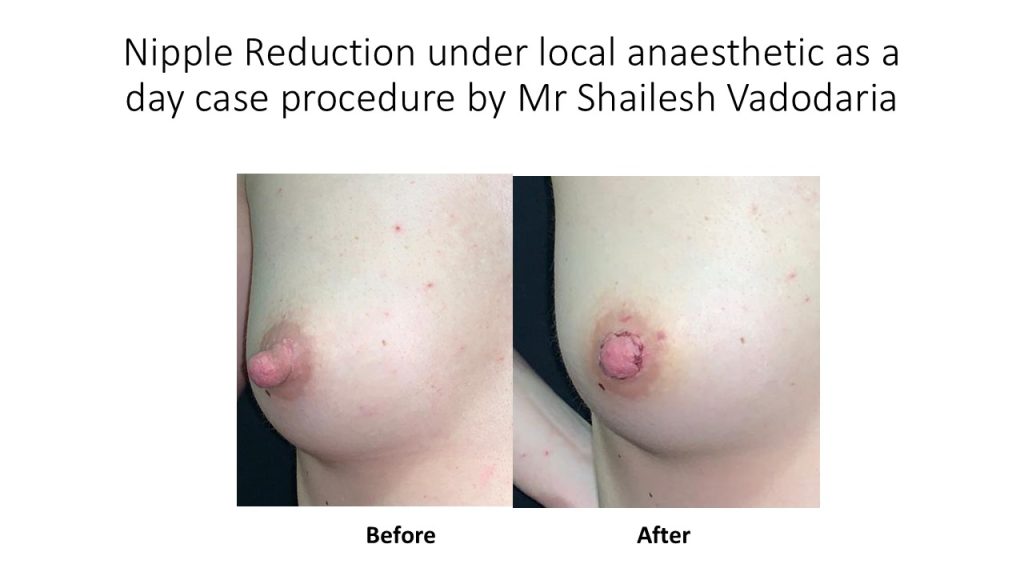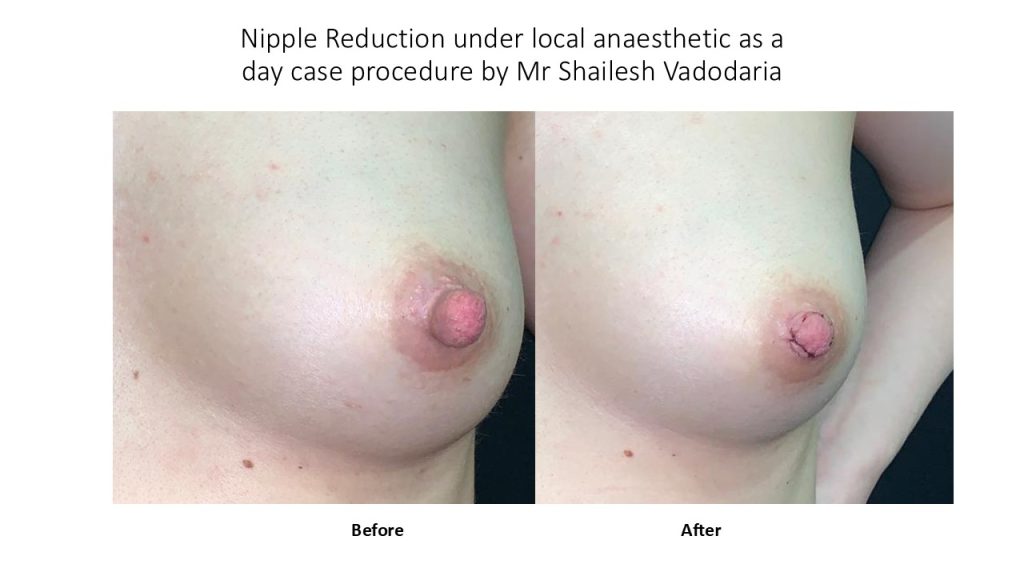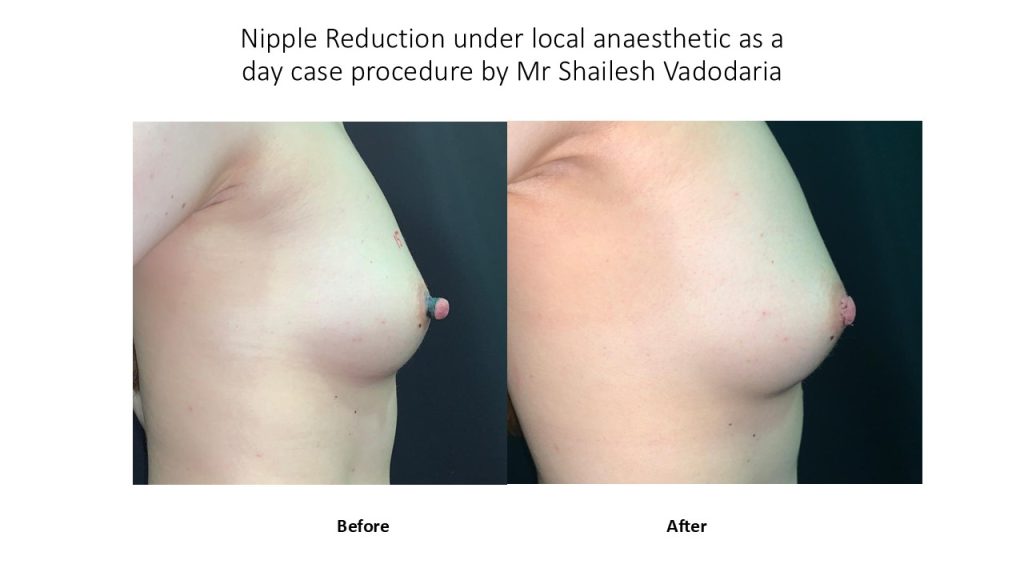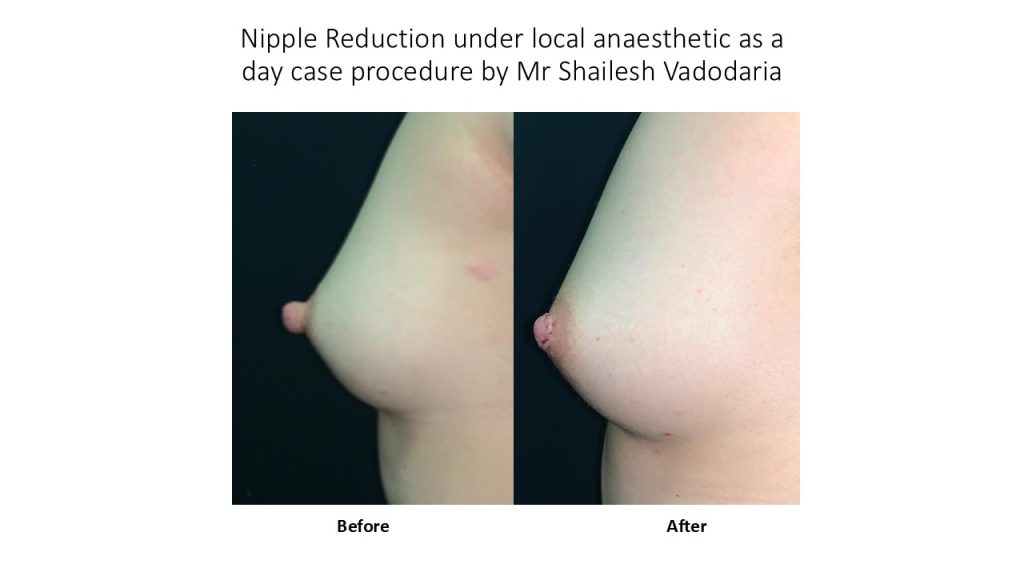Overview
Nipple reduction surgery is a commonly performed minor aesthetic procedure for women who are concerned about enlarged or prominent nipples. This condition—known medically as nipple hypertrophy—can cause both aesthetic dissatisfaction and physical discomfort.
For many women, enlarged nipples may become visible through clothing, rub or chafe against garments during sports, or become tender, swollen, and occasionally bleed. In others, it may cause self-consciousness in intimate settings and affect their confidence and quality of life.
Common Causes of Nipple Enlargement in Women
- Genetic predisposition — naturally larger nipples from adolescence
- Pregnancy and breastfeeding — stretching and hormonal stimulation can lead to nipple hypertrophy
- Age-related changes — gradual elongation and laxity of nipple tissues
- Repeated trauma or irritation — from friction against clothing or sports activity
- Piercings or inflammation — occasionally leading to residual tissue thickening
Indications for Nipple Reduction
Nipple reduction may be considered when one or more of the following are present:
- Cosmetic concern – nipples appearing prominent through swimwear, gym tops, or tight clothing
- Functional discomfort – rubbing, soreness, or bleeding due to friction during exercise or daily activities
- Asymmetry – one nipple larger or longer than the other
- Post-lactation changes – persistent hypertrophy following breastfeeding
- Emotional or psychological distress – embarrassment, intimacy concerns, or self-consciousness
Reconstructive indications – correction of nipple enlargement following breast surgery
Surgical Goals
At MACS Clinic, the aim of nipple reduction surgery in female patients is to:
- Reduce nipple projection
- Endeavour to minimise possibilities of loss of nipple sensation and to minimise the chances lactation functional compromise wherever possible
- To improve symmetry between both sides
- Minimize visible scarring and downtime
Surgical Technique (Female-Specific)
The nipple reduction procedure in female patients is carefully designed to preserve the lactiferous ducts—the milk-carrying channels that connect the nipple to the breast glandular tissue.
Key Surgical Principles at MACS Clinic:
- Local anaesthetic procedure — performed as an outpatient day case
- De-epithelialisation technique —
- A circumferential ring of skin around the nipple base is delicately de-epithelialised (outer skin layer removed).
- This allows reduction in nipple projection without transecting the core of the lactiferous ducts.
- A circumferential ring of skin around the nipple base is delicately de-epithelialised (outer skin layer removed).
- Preservation of central ducts — The central bulk of the nipple containing the ducts is preserved to maintain future breastfeeding potential.
- Tissue reshaping — The redundant outer portion of the nipple tissue is carefully reduced and reshaped for a natural contour.
- Fine absorbable sutures — to achieve smooth healing with minimal scarring.
This contrasts with partial amputation or wedge resection techniques commonly used in men, which are not appropriate in female patients desiring to retain lactational function.




Alternative Techniques (Literature Summary)
Several modifications have been described in peer-reviewed surgical literature:
Technique | Key Feature | Preservation of Ducts | Reference |
Circumferential de-epithelialisation | Removes outer skin ring, reduces projection | Excellent | Benito-Ruiz et al., Aesthetic Plast Surg (2005) |
Top hat technique | Horizontal wedge excision with duct preservation | Good | Kim et al., J Plast Reconstr Aesthet Surg (2011) |
Cylinder resection with duct preservation | Internal reduction via core sculpting | Good | Ishii et al., Plast Reconstr Surg (2005) |
Partial amputation (commonly used in men) | Removes nipple apex | Ducts divided – not suitable for women |
Contraindications
- Active infection or inflammation around the nipple
- Suspicious nipple discharge or breast lump (requires prior investigation)
- Uncontrolled systemic illness (e.g., diabetes, coagulopathy)
- Unrealistic aesthetic expectations
Current pregnancy or lactation period (should defer until complete)
Post-Operative Care at MACS Clinic
- Dressings:
- Small protective dressing applied for 3–5 days.
- Keep the area dry for initial 48 hours.
- Small protective dressing applied for 3–5 days.
- Pain and swelling:
- Mild discomfort for 2–3 days; managed with oral analgesics.
- Swelling and redness usually subside within one week.
- Mild discomfort for 2–3 days; managed with oral analgesics.
- Activity:
- Light activities within 24 hours; avoid strenuous exercise and tight bras for 10–14 days.
- Light activities within 24 hours; avoid strenuous exercise and tight bras for 10–14 days.
- Scar care:
- Fine absorbable sutures dissolve naturally.
- Scar maturation continues for several months; massage and silicone gels recommended after 3 weeks.
- Fine absorbable sutures dissolve naturally.
- Follow-up:
- Usually at 1 week, 3 months, and 6 months to monitor healing and symmetry.
- Usually at 1 week, 3 months, and 6 months to monitor healing and symmetry.
Risks and Complications
Although rare, possible complications include:
- Temporary/ permanent numbness or altered sensation
- Bleeding , infection , wound dehiscence
- Scar thickening or pigmentation changes
- Partial loss of projection (over-correction)
- Under correction
- Asymmetry
- Erection dysfunction
Can interference with lactation if ducts are inadvertently affected
Supporting References
- Benito-Ruiz, J., & Raigosa, M. (2005). Reduction of the Nipple–Areola Complex in the Female Breast: Aesthetic and Functional Considerations. Aesthetic Plastic Surgery, 29(4), 305–310.
- Ishii, N., et al. (2005). Nipple Reduction with Preservation of Lactiferous Ducts. Plastic and Reconstructive Surgery, 115(3), 872–878.
- Kim, Y. S., et al. (2011). Nipple Reduction: The “Top Hat” Technique for Duct Preservation in Women. Journal of Plastic, Reconstructive & Aesthetic Surgery, 64(9), 1186–1190.
- Khavanin, N., et al. (2014). Techniques and Outcomes in Nipple Reduction: A Systematic Review. Annals of Plastic Surgery, 73(3), 257–261.
- Hammond, D. C. (2017). Atlas of Aesthetic Breast Surgery (2nd Ed.) – Elsevier Saunders.
Summary
Nipple reduction surgery is a simple, safe, and rewarding procedure when performed with an understanding of anatomy, function, and aesthetics. At MACS Clinic, we endeavour duct-preserving techniques with consideration of breastfeeding ability.







